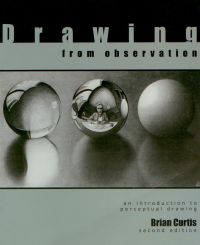
Drawing From Observation
by Brian Curtis
This is a highly informative book about observational drawing. One of the recurring themes is the distinction between what you see (percepts) and what you know (concepts). “There is meaningful conflict between what is perceived (convergence of parallel tracks) and our traditional rational understanding (Euclid’s theorem that parallel lines never meet)… To prevent your concepts from distorting your perceptions you must record the proportion you see, not the proportion you know.”
The initial step is called intuitive gesture, “a quick, all-encompassing, simultaneous overview of the wholeness of forms and their relationship in space. It is energetic, flexible, nonlinear, nonspecific, intuitive, and constantly open to adjustment… An intuitive gesture is a progressive process of perception, evaluation, correction, and reevaluation. You must be prepared to continuously make adjustments to your gesture drawing. You need to stay ‘loose’ and resist the tendency to define emerging shapes and to fixate on details at the beginning stages. When you start with a recognizable shape of an object, it is most frequently based more on what you think than on what you see.”
The author explains a method to check the accuracy of a drawing by imagining a grid in front of the picture plane. By holding up a straight edge, you can compare the placement of objects with the x,y coordinates of the Mondrian grid lines. “Intuitive gesture first. Mondrian second.”
Another clever technique is to use an imaginary clock to measure angles. If you observe a receding edge lining up with 2 o’clock, you then draw a line consistent with that angle.
It’s easy to understand that if the subject moves, it will throw off the drawing. But the author emphasizes that it is equally important for the artist to draw from a fixed position. There is actually a term for this: “Parallax. n. the apparent displacement of an observed object due to a change in the position of the observer.”
The book explains atmospheric perspective. “It is based on the perceptual principle that objects nearer to the observer appear more focused and in greater contrast to the background than those further away.” There are also two chapters on linear perspective, including 1-, 2-, and 3-point perspective.
“Chiaroscuro is a drawing technique where subtly blended shades of gray are applied to imitate the varying intensities of light and shadow that occur when light illuminates and is reflected off three-dimensional forms.” In other words: shading. “Capturing the subtle variations that occur when light reflects off neighboring objects is perhaps the most important element of a chiaroscuro drawing. Reflected light takes what would otherwise be individually illuminated objects and integrates them by means of a delicate dance of bouncing photons, into a consistent and coherent illusion of spatial relationships.”
Foreshortening refers to depicting an object lying at an angle to the picture plane. “Failure to correctly foreshorten a rectilinear plane that is moving back in space is the most common error in observational drawing.” There is an entire chapter on foreshortened circles, aka ellipses. “Instead of appearing perfectly round, circles that move up, down, or across the picture plane or those that tilt away from the observer appear visually foreshortened, compressed along one axis. A foreshortened circle that is compressed along one axis looks exactly like an ellipse.”
The book includes an interesting chapter on The Golden Mean, aka The Rule of Thirds, which is also represented by the Greek letter Φ (phi). The Golden Mean is a ratio of 1.6180:1. The author shows how this proportional relationship applies to various historic works of art and architecture including da Vinci’s Vitruvian Man, Michelangelo’s Creation of Adam, The Parthenon, and Stonehenge.
The book also includes chapters on cross-contour and biomorphic forms. “Drawing through the form with light, gossamer-like lines enhances the three-dimensional illusion of forms in space.”
The last chapter is on composition. “Now that you have successfully worked your way through the full array of perceptual drawing projects, your final challenge is to apply your newly acquired knowledge and skills to the creation of pictorial compositions that attract, engage, stimulate, and entertain the viewer’s eye… Unity, harmony, coherence, and wholeness in the visual field contribute to a satisfying, pleasurable, and engaging perceptual experience… Organized picture fields attract and engage they eye; disorganized fields repel it.”
“Symmetrical balance is generally regarded as pleasing but it is considered to be predictable and therefore less emotionally engaging than asymmetrical balance… One of the most surprising and dramatic methods for creating asymmetrical equilibrium is to balance identifiable shapes with empty space.”
“If you generously apply perceptual grid lines, clock-angles, positive/negative shape correspondence, and the proportion tool at each and every stage of an extended gesture drawing, you will gradually fine-tune your initial intuitive estimates and arrive at surprisingly accurate depictions of sophisticated spatial relationships.”
How do you know when a drawing is finished? “A drawing is considered complete when it is sensitively constructed and internally consistent.”
Curtis, Brian. Drawing from Observation: An Introduction to Perceptual Drawing. 2nd ed. Boston: McGraw-Hill, 2009. Order from Amazon.com
Disclosure: As an Amazon Associate I earn from qualifying purchases.